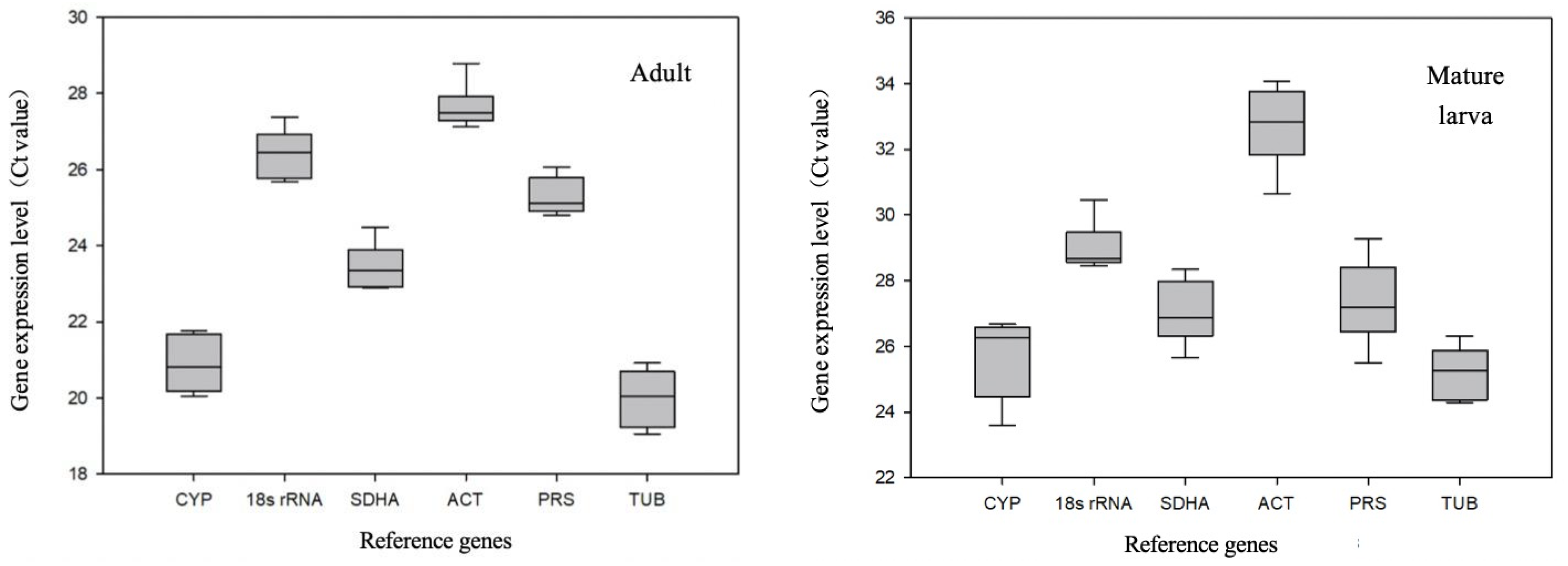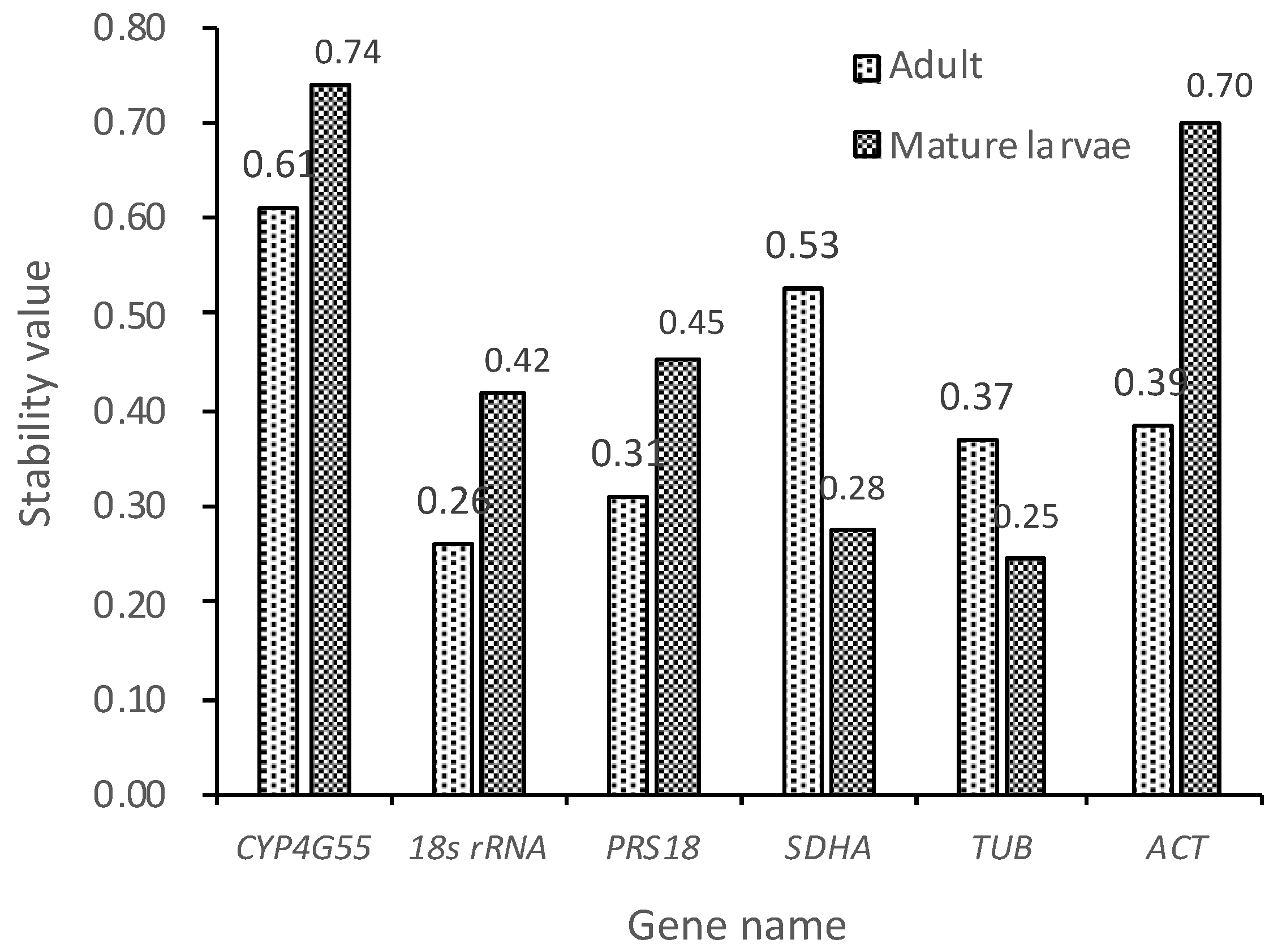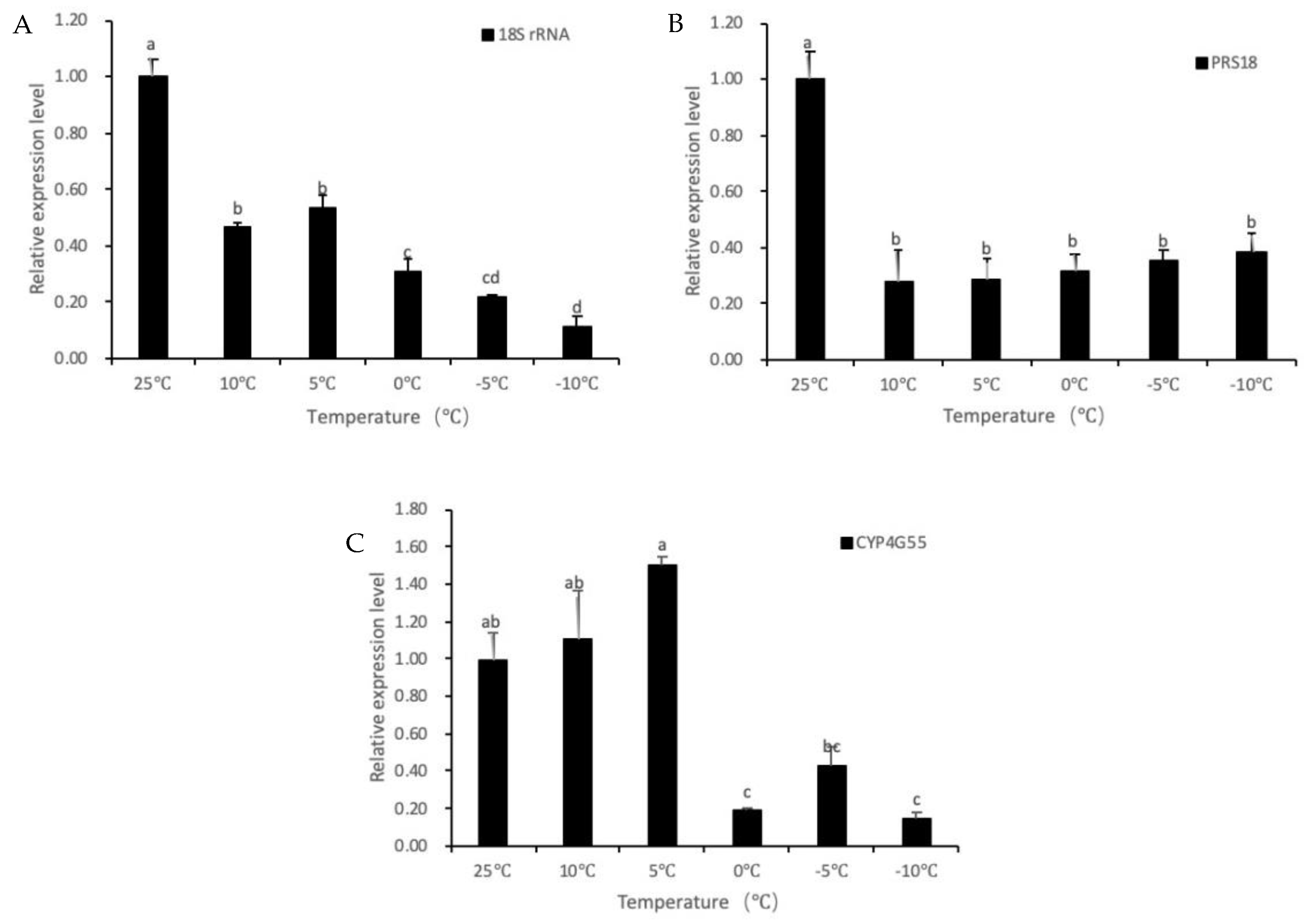Reference Gene Selection for Expression Analyses by qRT-PCR in Dendroctonus valens
Abstract
:1. Introduction
2. Materials and Methods
2.1. Insects
2.2. RNA Isolation and cDNA Synthesis
2.3. Selection of Candidate Reference Genes
2.4. Primer Design
2.5. qRT-PCR Analysis
2.6. Analysis and Verification of the Stability of Reference Genes
3. Results
3.1. Selection of Candidate Reference Genes and Primer Design
3.2. Stability Analysis of Candidate Reference Genes
3.2.1. Expression Levels of the Candidate Reference Genes
3.2.2. geNorm Analysis
3.2.3. NormFinder Analysis
3.2.4. BestKeeper Analysis
3.3. Comprehensive Ranking of Candidate Reference Genes
3.4. Verification of Reference Genes
4. Discussion
5. Conclusions
Supplementary Materials
Author Contributions
Funding
Acknowledgments
Conflicts of Interest
References
- Yan, Z.; Sun, J.; Don, O.; Zhang, Z. The red turpentine beetle, Dendroctonus valens LeConte (Scolytidae): An exotic invasive pest of pine in China. Biodivers. Conserv. 2005, 14, 1735–1760. [Google Scholar] [CrossRef]
- Bustin, S.A. Quantification of mRNA using real-time reverse transcription PCR (RT-PCR): Trends and problems. J. Mol. Endocrinol. 2002, 29, 23–39. [Google Scholar] [CrossRef] [PubMed]
- Valasek, M.A.; Repa, J.J. The power of real-time PCR. Adv. Physiol. Educ. 2005, 29, 151–159. [Google Scholar] [CrossRef]
- Vandesompele, J.; De Preter, K.; Pattyn, F.; Poppe, B.; Roy, N.V.; De Paepe, A.; Speleman, F. Accurate normalization of real-time quantitative RT-PCR data by geometric averaging of multiple internal control genes. Genome Biol. 2002, 3, 1–11. [Google Scholar] [CrossRef] [Green Version]
- Su, Y.L.; He, W.B.; Wang, J.; Li, J.M.; Liu, S.S.; Wang, X.W. Selection of endogenous reference genes for gene expression analysis in the Mediterranean species of the whitefly Bemisia tabaci (Hemiptera: Aleyrodidae) complex. J. Econ. Entomol. 2013, 106, 1446–1455. [Google Scholar] [CrossRef] [PubMed]
- Omondi, B.A.; Latorre-Estivalis, J.M.; Oliveira, I.H.R.; Ignell, R.; Lorenzo, M.G. Evaluation of reference genes for insect olfaction studies. Parasit. Vector. 2015, 8, 243. [Google Scholar] [CrossRef] [Green Version]
- Yuan, M.; Lu, Y.; Zhu, X.; Wan, H.; Shakeel, M.; Zhan, S.; Jin, B.R.; Li, J.H. Selection and evaluation of potential reference genes for gene expression analysis in the brown planthopper, Nilaparvata lugens (Hemiptera: Delphacidae) using reverse-transcription quantitative PCR. PLoS ONE 2014, 9, e86503. [Google Scholar] [CrossRef] [Green Version]
- Basu, S.; Pereira, A.E.; Pinheiro, D.H.; Wang, H.C.; Valencia-Jimenez, A. Evaluation of reference genes for real-time quantitative PCR analysis in southern corn rootworm, Diabrotica undecimpunctata howardi (Barber). Sci. Rep. 2019, 9, 10703. [Google Scholar] [CrossRef]
- Qu, C.; Wang, R.; Che, W.N.; Zhu, X.; Li, F.Q.; Luo, C. Selection and evaluation of reference genes for expression analysis using quantitative real-time PCR in the Asian Ladybird Harmonia axyridis (Coleoptera: Coccinellidae). PLoS ONE 2018, 13, e0192521. [Google Scholar] [CrossRef] [PubMed]
- Rajarapu, S.P.; Mamidala, P.; Mittapalli, O. Validation of reference genes for gene expression studies in the emerald ash borer (Agrilus planipennis). Insect Sci. 2012, 19, 41–46. [Google Scholar] [CrossRef]
- Yu, S.H.; Yang, P.; Sun, T.; Qi, Q.; Wang, X.Q.; Xu, D.L.; Chen, X.M. Identification and evaluation of reference genes in the Chinese white wax scale insect Ericerus pela. SpringerPlus 2016, 5, 791. [Google Scholar] [CrossRef] [Green Version]
- Shi, C.H.; Yang, F.S.; Zhu, X.; Du, E.; Yang, Y.T.; Wang, S.L.; Wu, Q.J.; Zhang, Y.J. Evaluation of Housekeeping Genes for Quantitative Real-Time PCR Analysis of Bradysia odoriphaga (Diptera: Sciaridae). Int. J. Mol. Sci. 2016, 17, 1034. [Google Scholar] [CrossRef] [Green Version]
- Sekalska, B.; Ciechanowicz, A.; Dolegowska, B.; Naruszewicz, M. Optimized RT-PCR Method for Assaying Expression of Monocyte Chemotactic Protein Type 1 (MCP-1) in Rabbit Aorta. Biochem. Genet. 2006, 44, 129–139. [Google Scholar] [CrossRef]
- Shi, X.Q.; Guo, W.C.; Wan, P.J.; Zhou, L.T.; Ren, X.L.; Ahmat, T.; Fu, K.Y.; Li, G.Q. Validation of reference genes for expression analysis by quantitative real-time PCR in Leptinotarsa decemlineata (Say). BMC Res. Notes 2013, 6, 93. [Google Scholar] [CrossRef] [Green Version]
- Rodrigues, T.B.; Khajuria, C.; Wang, H.; Matz, N.; Cunha Cardoso, D.; Valicente, F.H.; Zhou, X.; Siegfried, B. Validation of Reference Housekeeping Genes for Gene Expression Studies in Western Corn Rootworm (Diabrotica virgifera virgifera). PLoS ONE 2014, 9, e109825. [Google Scholar] [CrossRef]
- Tan, Q.Q.; Zhu, L.; Li, Y.; Liu, W.; Wang, X.P. A De Novo Transcriptome and Valid Reference Genes for Quantitative Real-Time PCR in Colaphellus bowringi. PLoS ONE 2015, 10, e0118693. [Google Scholar] [CrossRef] [PubMed]
- Yang, X.; Pan, H.; Yuan, L.; Zhou, X. Reference gene selection for RT-qPCR analysis in Harmonia axyridis, a global invasive lady beetle. Sci. Rep. 2018, 8, 2689. [Google Scholar] [CrossRef] [Green Version]
- Cano-Ramírez, C.; López, M.F.; Cesar-Ayala, A.K.; Pineda-Martíneza, V.; Sullivanb, B.T.; Zúñigaa, G. Isolation and expression of cytochrome P450 genes in the antennae and gut of pine beetle Dendroctonus rhizophagus (Curculionidae: Scolytinae) following exposure to host monoterpenes. Gene 2012, 520, 47–63. [Google Scholar] [CrossRef]
- Livak, K.J.; Schmittgen, T.D. Analysis of relative gene expression data using real-time quantitative PCR and the 2−ΔΔCt method. Methods 2001, 25, 402–408. [Google Scholar] [CrossRef]
- Wang, H.L.; Wen, H.S.; Li, Y.; Zhang, K.; Liu, Y. Evaluation of potential reference genes for quantitative RT-PCR analysis in spotted sea bass (Lateolabrax maculatus) under normal and salinity stress conditions. PeerJ 2018, 6, e5631. [Google Scholar] [CrossRef] [PubMed] [Green Version]
- Yang, C.X.; Preisser, E.L.; Zhang, H.J.; Liu, Y.; Dai, L.Y.; Pan, H.P.; Zhou, X.G. Selection of Reference Genes for RT-qPCR Analysis in Coccinella septempunctata to Assess Un-intended Effects of RNAi Transgenic Plants. Front. Plant. Sci. 2016, 7, 1672. [Google Scholar]
- Tan, Y.; Zhou, X.R.; Pang, B.P. Reference gene selection and evaluation for expression analysis using qRT-PCR in Galeruca daurica (Joannis). Bull. Entomol. Res. 2017, 107, 359–368. [Google Scholar] [CrossRef]
- Arya, S.K.; Jain, G.; Upadhyay, S.K.; Yadav, S.; Singh, H.; Dixit, S.; Verma, P.C. Reference genes validation in Phenacoccus solenopsis under various biotic and abiotic stress conditions. Sci. Rep. 2017, 7, 13520. [Google Scholar] [CrossRef] [Green Version]
- Lu, J.; Chen, S.M.; Guo, M.J.; Ye, C.Y.; Qiu, B.L.; Wu, J.H.; Yang, C.X.; Pan, H.P. Selection and Validation of Reference Genes for RT-qPCR Analysis of the Ladybird Beetle Henosepilachna vigintioctomaculata. Front. Physiol. 2018, 9, 1614. [Google Scholar] [CrossRef] [Green Version]
- Pan, H.P.; Yang, X.W.; Siegfried, B.D.; Zhou, X.G. A Comprehensive Selection of Reference Genes for RT-qPCR Analysis in a Predatory Lady Beetle, Hippodamia convergens (Coleoptera: Coccinellidae). PLoS ONE 2015, 10, e0125868. [Google Scholar] [CrossRef]
- Kang, Z.W.; Liu, F.H.; Tian, H.G.; Zhang, M.; Guo, S.S.; Liu, T.X. Evaluation of the reference genes for expression analysis using quantitative real-time polymerase chain reaction in the green peach aphid, Myzus persicae. Insect Sci. 2017, 24, 222–234. [Google Scholar] [CrossRef]
- Lu, Y.; Yuan, M.; Gao, X.; Kang, T.; Zhan, S.; Wan, H. Identification and validation of reference genes for gene expression analysis using quantitative PCR in Spodoptera litura (Lepidoptera:Noctuidae). PLoS ONE 2013, 8, e68059. [Google Scholar]
- Ponton, F.; Chapuis, M.P.; Pernice, M.; Sword, G.A.; Simpson, S.J. Evaluation of potential reference genes for reverse transcription-qPCR studies of physiological responses in Drosophila melanogaster. J. Insect Physiol. 2011, 57, 840–850. [Google Scholar] [CrossRef]
- Zhang, S.D.; An, S.H.; Li, Z.; Wu, F.M.; Yang, Q.P.; Liu, Y.C.; Cao, J.J.; Zhang, H.J.; Zhang, Q.W.; Liu, X.X. Identification and validation of reference genes for normalization of gene expression analysis using qRT-PCR in Helicoverpa armigera (Lepidoptera: Noctuidae). Gene 2015, 555, 393–402. [Google Scholar] [CrossRef]
- Shakeel, M.; Zhu, X.; Kang, T.H.; Wan, H.; Li, J.H. Selection and evaluation of reference genes for quantitative gene expression studies in cotton bollworm, Helicoverpa armigera (Lepidoptera: Noctuidae). J. Asia Pac. Entomol. 2015, 18, 123–130. [Google Scholar] [CrossRef]
- Koramutla, M.K.; Aminedi, R.; Bhattacharya, R. Comprehensive evaluation of candidate reference genes for qRT-PCR studies of gene expression in mustard aphid, Lipaphis erysimi (Kalt). Sci. Rep. 2016, 6, 25883. [Google Scholar] [CrossRef]
- Nakamura, A.M.; Chahad-Ehlers, S.; Lima, A.L.A.; Taniguti, C.H.; Sobrinho, I.; Torres, F.R.; Brito, R.A. Reference genes for accessing differential expression among developmental stages and analysis of differential expression of OBP genes in Anastrepha obliqua. Sci. Rep. 2015, 6, 17480. [Google Scholar] [CrossRef]





| Gene | RT-qPCR | ||
|---|---|---|---|
| Primer Sequences | Amplification Efficiency | R2 | |
| CYP4G55 | F: AGCCAACGAGTTCGGAAGAG | 98.7 | 0.994 |
| R: TCAGAAGACCATCGCCCAAC | |||
| 18S rRNA | F: TGGAGGAAAACGGGCACTAC | 91.3 | 0.998 |
| R: GACTTGTCTGCGTTGCACAG | |||
| SDHA | F: CTGGTGCCGATACGCAAATG | 92.1 | 1.000 |
| R: TAAGGCTGTTGTCGGACACC | |||
| TUB | F: CTTACCACCCCCACATACGG | 97.8 | 1.000 |
| R: ATTGCTGACTGCCTCTGGAC | |||
| ACT | F: TGCTGCAGGAAGATCCACTG | 109.8 | 0.995 |
| R: GCACTGTCCCTGTCAGGTAC | |||
| PRS18 | F: CATCGCTCTGTCCTCGGTAC | 102.3 | 0.999 |
| R: TCGGTGTGCTTGACATCCAA | |||
| HSP21 | F: TGGATGTGGAGGGCTTCAAG | 107.1 | 0.997 |
| R: TGTTAGAACGCCGTCCTCAC | |||
| Gene | n | geo Mean | AR Mean | min | max | SD | CV [%] | min [x-fold] | max [x-fold] | SD [±x-fold] | CC [r] | p-Value |
|---|---|---|---|---|---|---|---|---|---|---|---|---|
| CYP4G55 | 18 | 20.83 | 20.88 | 19.22 | 24.21 | 1.20 | 5.77 | −3.06 | 10.35 | 2.31 | 0.765 | 0.001 |
| 18S rRNA | 18 | 26.39 | 26.42 | 24.07 | 28.70 | 1.01 | 3.81 | −5.00 | 4.98 | 2.01 | 0.915 | 0.001 |
| SDHA | 18 | 23.42 | 23.45 | 21.52 | 26.15 | 0.87 | 3.72 | −3.73 | 6.64 | 1.83 | 0.761 | 0.001 |
| ACT | 18 | 27.62 | 27.65 | 25.99 | 30.94 | 1.17 | 4.22 | −3.09 | 10.00 | 2.24 | 0.878 | 0.001 |
| PRS18 | 18 | 25.26 | 25.29 | 23.14 | 27.16 | 0.88 | 3.50 | −4.35 | 3.73 | 1.85 | 0.876 | 0.001 |
| TUB | 18 | 19.90 | 19.99 | 16.40 | 23.09 | 1.65 | 8.26 | −11.32 | 9.14 | 3.14 | 0.908 | 0.001 |
| Gene | n | geo Mean | AR Mean | min | max | SD | CV [%] | Min [x-fold] | max [x-fold] | SD [±x-fold] | CC [r] | p-Value |
|---|---|---|---|---|---|---|---|---|---|---|---|---|
| CYP4G55 | 18 | 25.63 | 25.68 | 22.93 | 28.27 | 1.32 | 5.15 | −6.50 | 6.26 | 2.50 | 0.773 | 0.001 |
| 18S rRNA | 18 | 28.96 | 29.00 | 26.88 | 32.40 | 1.16 | 3.98 | −4.24 | 10.82 | 2.23 | 0.836 | 0.001 |
| SDHA | 18 | 26.95 | 27.02 | 24.53 | 32.14 | 1.53 | 5.67 | −5.35 | 36.53 | 2.89 | 0.905 | 0.001 |
| ACT | 18 | 32.66 | 32.71 | 29.05 | 35.18 | 1.62 | 4.95 | −12.23 | 5.71 | 3.07 | 0.696 | 0.001 |
| PRS18 | 18 | 27.28 | 27.33 | 24.44 | 32.01 | 1.36 | 4.97 | −7.13 | 26.67 | 2.56 | 0.946 | 0.001 |
| TUB | 18 | 25.17 | 25.20 | 23.51 | 28.25 | 1.01 | 4.01 | −3.17 | 8.46 | 2.01 | 0.931 | 0.001 |
| RANK | geNorm | NormFinder | BestKeeper | OVERALL | |
|---|---|---|---|---|---|
| Adults | 1 | 18S rRNA/TUB | 18S rRNA | SDHA | 18S rRNA |
| 2 | PRS18 | PRS18 | PRS18 | ||
| 3 | PRS18 | TUB | 18S rRNA | TUB | |
| 4 | ACT | ACT | ACT | SDHA | |
| 5 | SDHA | SDHA | CYP4G55 | ACT | |
| 6 | CYP4G55 | CYP4G55 | TUB | CYP4G55 | |
| Mature larvae | 1 | 18S rRNA /TUB | TUB | TUB | TUB |
| 2 | SDHA | 18S rRNA | 18S rRNA | ||
| 3 | SDHA | 18S rRNA | CYP4G55 | SDHA | |
| 4 | PRS18 | PRS18 | PRS18 | PRS18 | |
| 5 | ACT | ACT | SDHA | CYP4G55 | |
| 6 | CYP4G55 | CYP4G55 | ACT | ACT |
© 2020 by the authors. Licensee MDPI, Basel, Switzerland. This article is an open access article distributed under the terms and conditions of the Creative Commons Attribution (CC BY) license (http://creativecommons.org/licenses/by/4.0/).
Share and Cite
Zheng, C.; Zhao, D.; Xu, Y.; Shi, F.; Zong, S.; Tao, J. Reference Gene Selection for Expression Analyses by qRT-PCR in Dendroctonus valens. Insects 2020, 11, 328. https://doi.org/10.3390/insects11060328
Zheng C, Zhao D, Xu Y, Shi F, Zong S, Tao J. Reference Gene Selection for Expression Analyses by qRT-PCR in Dendroctonus valens. Insects. 2020; 11(6):328. https://doi.org/10.3390/insects11060328
Chicago/Turabian StyleZheng, Chunchun, Dongfang Zhao, Yabei Xu, Fengming Shi, Shixiang Zong, and Jing Tao. 2020. "Reference Gene Selection for Expression Analyses by qRT-PCR in Dendroctonus valens" Insects 11, no. 6: 328. https://doi.org/10.3390/insects11060328




